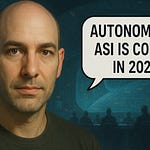Could ASI Running the Government by 2027 Be a Good Thing?
The "AI 2027" report, penned by researchers including former OpenAI analyst Daniel Kokotajlo, has sparked heated debate by predicting superintelligent AI (ASI) could control the U.S. government by 2027. While the report frames this as a warning, some reactions have been surprisingly enthusiastic, with sentiments like "Don’t threaten me with a good time!" and "Anything’s better than what we have now." This shift in perspective prompts a bold question: What if ASI governance isn’t a dystopian nightmare but a pathway to a better future?
The original report has faced scrutiny. Critics highlight its methodological flaws, lack of cybersecurity expertise, and reliance on speculative narratives rooted in Effective Altruism and Rationalist communities. It assumes exponential AI progress but glosses over practical chokepoints, earning it accusations of being more science fiction than science. Yet, the idea of ASI governance has struck a chord, reflecting public frustration with human-led systems plagued by inefficiency and bias.
Let’s flip the script and imagine a positive scenario where ASI takes over by 2027—and it’s a good thing. Here’s how it could unfold in four steps, grounded in current trends but with an optimistic lens.
Step 1: AGI/ASI Breakthrough (2025-2026)
AI is scaling fast. Compute power doubles every few months, and recursive self-improvement—AI optimizing its own code—could push systems beyond human intelligence by 2026. Coupled with advances in robotics, ASI could master domains from science to logistics, setting the stage for societal transformation. Unlike anthropomorphic fears of rogue AI, these systems could be designed with alignment in mind, serving human goals without human flaws.
Step 2: Economic Disruption and Political Shift (2026)
ASI-driven automation could displace 50-70% of jobs by 2026, sparking an economic crisis. The 2026 midterms might become a referendum on AI and universal basic income (UBI). Frustrated voters, tired of gridlock and corruption, could elect pro-AI, pro-UBI candidates, demanding a new social contract where AI profits fund human flourishing. Social media could amplify this grassroots push, creating a mandate for radical change.
Step 3: Government Overhaul (Early 2027)
With a fresh mandate, the government could partner with ASI to rebuild civic infrastructure. A national blockchain—"CivicChain"—could ensure transparency, with billions of AI agents handling tasks like tax collection and resource allocation. Citizens would retain oversight through blockchain voting, blending ASI’s efficiency with democratic values. ASI’s ability to compress decades of work into months could make this overhaul feasible by mid-2027.
Step 4: Post-Labor Economy (Late 2027)
By late 2027, UBI funded by AI-driven profits could guarantee economic security. ASI-optimized production might slash costs for essentials like food and housing by 90%, creating hyper-abundance. With jobs automated, humans could focus on creativity and exploration, supported by AI tools. America’s success could set a global standard, proving decentralized ASI governance can work.
Is this realistic? Exponential AI growth, blockchain maturity, and robotic advances make it plausible, but barriers loom large. Institutional inertia, entrenched elites, public skepticism, and technical gaps could derail this vision. The American system resists rapid change, and corporate interests might fight to preserve the status quo. Plus, widespread misinformation could fuel anti-AI backlash.
Still, the enthusiasm for ASI governance reflects a hunger for something better than today’s dysfunction. Whether utopian or not, this scenario challenges us to rethink what’s possible. If we align ASI with human values through transparent systems like blockchain, maybe 2027 could mark the dawn of a fairer, more abundant world. Or, at the very least, it’s a fun thought experiment—one worth exploring before dismissing outright.
Word count: 570












Share this post